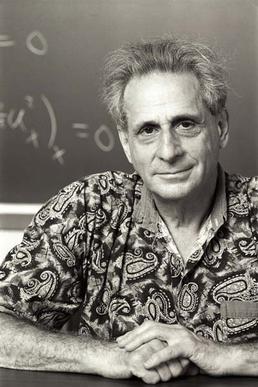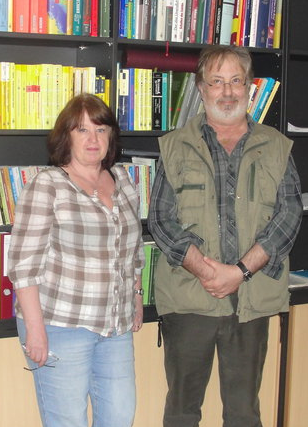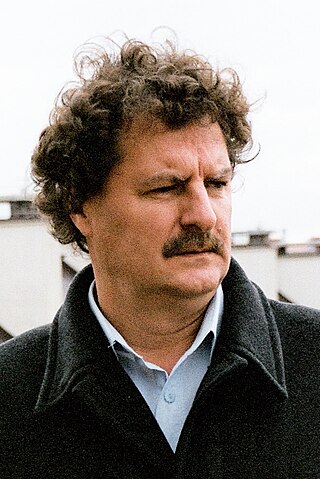Related Research Articles
In theoretical physics, the Einstein–Cartan theory, also known as the Einstein–Cartan–Sciama–Kibble theory, is a classical theory of gravitation, one of several alternatives to general relativity. The theory was first proposed by Élie Cartan in 1922.

Jean Louis, baron Bourgain was a Belgian mathematician. He was awarded the Fields Medal in 1994 in recognition of his work on several core topics of mathematical analysis such as the geometry of Banach spaces, harmonic analysis, ergodic theory and nonlinear partial differential equations from mathematical physics.

Martin David Kruskal was an American mathematician and physicist. He made fundamental contributions in many areas of mathematics and science, ranging from plasma physics to general relativity and from nonlinear analysis to asymptotic analysis. His most celebrated contribution was in the theory of solitons.
For classical dynamics at relativistic speeds, see relativistic mechanics.

Alan David Weinstein is a professor of mathematics at the University of California, Berkeley, working in the field of differential geometry, and especially in Poisson geometry.
Einstein–Cartan–Evans theory or ECE theory was an attempted unified theory of physics proposed by the Welsh chemist and physicist Myron Wyn Evans, which claimed to unify general relativity, quantum mechanics and electromagnetism. The hypothesis was largely published in the journal Foundations of Physics Letters between 2003 and 2005. Several of Evans's central claims were later shown to be mathematically incorrect and, in 2008, the new editor of Foundations of Physics, Nobel laureate Gerard 't Hooft, published an editorial note effectively retracting the journal's support for the hypothesis.
In mathematics, a differential invariant is an invariant for the action of a Lie group on a space that involves the derivatives of graphs of functions in the space. Differential invariants are fundamental in projective differential geometry, and the curvature is often studied from this point of view. Differential invariants were introduced in special cases by Sophus Lie in the early 1880s and studied by Georges Henri Halphen at the same time. Lie (1884) was the first general work on differential invariants, and established the relationship between differential invariants, invariant differential equations, and invariant differential operators.

Maurice A. de Gosson, is an Austrian mathematician and mathematical physicist, born in Berlin. He is currently a Senior Researcher at the Numerical Harmonic Analysis Group (NuHAG) of the University of Vienna.
In physics, Born reciprocity, also called reciprocal relativity or Born–Green reciprocity, is a principle set up by theoretical physicist Max Born that calls for a duality-symmetry among space and momentum. Born and his co-workers expanded his principle to a framework that is also known as reciprocity theory.
In physics, non-Hermitian quantum mechanics describes quantum mechanical systems where Hamiltonians are not Hermitian.

Janusz Roman Grabowski is a Polish mathematician working in differential geometry and mathematical methods in classical and quantum physics.

Time-translation symmetry or temporal translation symmetry (TTS) is a mathematical transformation in physics that moves the times of events through a common interval. Time-translation symmetry is the law that the laws of physics are unchanged under such a transformation. Time-translation symmetry is a rigorous way to formulate the idea that the laws of physics are the same throughout history. Time-translation symmetry is closely connected, via Noether's theorem, to conservation of energy. In mathematics, the set of all time translations on a given system form a Lie group.
Elizabeth Louise Mansfield is an Australian mathematician whose research includes the study of moving frames and conservation laws for discretisations of physical systems. She is a Fellow of the Institute of Mathematics and its Applications and was a Vice-President thereof from January 2015 until December 2018. She was the first female full professor of mathematics at the University of Kent. She was one of the co-editors of the LMS Journal of Computation and Mathematics, a journal published by the London Mathematical Society from 1998 to 2015. She is on the Editorial Board of the Journal of the Foundations of Computational Mathematics.
Nail Hairullovich Ibragimov was a Russian mathematician and mathematical physicist. At his death he was a professor emeritus at the Blekinge Institute of Technology. Ibragimov's research area was differential calculus, group analysis and mathematical physics. He was the author of many books on mathematics and mathematical physics.

Alexandre Mikhailovich Vinogradov was a Russian and Italian mathematician. He made important contributions to the areas of differential calculus over commutative algebras, the algebraic theory of differential operators, homological algebra, differential geometry and algebraic topology, mechanics and mathematical physics, the geometrical theory of nonlinear partial differential equations and secondary calculus.
Integrable algorithms are numerical algorithms that rely on basic ideas from the mathematical theory of integrable systems.

Alain Goriely is a Belgian mathematician, currently holding the statutory professorship (chair) of mathematical modelling at the University of Oxford, Mathematical Institute. He is director of the Oxford Centre for Industrial Mathematics (OCIAM), of the International Brain and Mechanics Lab (IBMTL) and Professorial Fellow at St Catherine's College, Oxford. At the Mathematical Institute, he was the director of external relations and public engagement, from 2013 until 2022, initiating the Oxford Mathematics series of public lectures. In 2022, he was elected to the Royal Society, and Gresham Professor of Geometry at the Gresham College (London) in 2024.

Physics-informed neural networks (PINNs), also referred to as Theory-Trained Neural Networks (TTNs), are a type of universal function approximators that can embed the knowledge of any physical laws that govern a given data-set in the learning process, and can be described by partial differential equations (PDEs). Low data availability for some biological and engineering problems limit the robustness of conventional machine learning models used for these applications. The prior knowledge of general physical laws acts in the training of neural networks (NNs) as a regularization agent that limits the space of admissible solutions, increasing the generalizability of the function approximation. This way, embedding this prior information into a neural network results in enhancing the information content of the available data, facilitating the learning algorithm to capture the right solution and to generalize well even with a low amount of training examples.
Group analysis of differential equations is a branch of mathematics that studies the symmetry properties of differential equations with respect to various transformations of independent and dependent variables. It includes methods and applied aspects of differential geometry, Lie groups and algebras theory, calculus of variations and is, in turn, a powerful research tool in theories of ODEs, PDEs, mathematical and theoretical physics.
References
- 1 2 "Peter Olver | AMAAZE". amaaze.umn.edu. Retrieved 2021-11-28.
- 1 2 Peter Olver at the Mathematics Genealogy Project
- 1 2 3 Peter J. Olver. "Curriculum Vitae" (PDF). Retrieved 19 June 2017.
- ↑ "FoCM • Foundations of Computational Mathematics • Governance". focm-society.org. Retrieved 2021-11-28.
- ↑ "FoCM • Foundations of Computational Mathematics • Governance". focm-society.org. Retrieved 2021-11-28.
- ↑ "FoCM • Foundations of Computational Mathematics • Governance". focm-society.org. Retrieved 2021-11-28.
- ↑ AMS. "List of Fellows of the American Mathematical Society" . Retrieved 19 June 2017.
- ↑ "SIAM > Prizes & Recognition > Fellows Program > All SIAM Fellows > Class of 2014". www.siam.org. Retrieved 2021-11-28.
- ↑ "ISIMM Home Page". isimm.unipg.it. Retrieved 2021-11-28.
- ↑ Olver, Peter J. (1977-06-01). "Evolution equations possessing infinitely many symmetries". Journal of Mathematical Physics. 18 (6): 1212–1215. Bibcode:1977JMP....18.1212O. doi: 10.1063/1.523393 . ISSN 0022-2488.
- ↑ Olver, Peter J.; Rosenau, Philip (1986-02-10). "The construction of special solutions to partial differential equations". Physics Letters A. 114 (3): 107–112. Bibcode:1986PhLA..114..107O. doi:10.1016/0375-9601(86)90534-7. ISSN 0375-9601.
- ↑ Olver, Peter J.; Rosenau, Philip (1987-04-01). "Group-Invariant Solutions of Differential Equations". SIAM Journal on Applied Mathematics. 47 (2): 263–278. doi:10.1137/0147018. ISSN 0036-1399.
- ↑ Fels, Mark; Olver, Peter J. (1998-04-01). "Moving Coframes: I. A Practical Algorithm". Acta Applicandae Mathematicae. 51 (2): 161–213. doi:10.1023/A:1005878210297. ISSN 1572-9036. S2CID 6681218.
- ↑ Fels, Mark; Olver, Peter J. (1999-01-01). "Moving Coframes: II. Regularization and Theoretical Foundations". Acta Applicandae Mathematicae. 55 (2): 127–208. doi:10.1023/A:1006195823000. ISSN 1572-9036. S2CID 826629.
- ↑ Olver, Peter J. (2007-09-01). "Generating differential invariants". Journal of Mathematical Analysis and Applications. Special issue dedicated to William Ames. 333 (1): 450–471. Bibcode:2007JMAA..333..450O. doi: 10.1016/j.jmaa.2006.12.029 . ISSN 0022-247X.
- ↑ Olver, Peter J.; Pohjanpelto, Juha; Valiquette, Francis (2009-07-23). "On the Structure of Lie Pseudo-Groups". SIGMA. Symmetry, Integrability and Geometry: Methods and Applications. 5: 077. arXiv: 0907.4086 . Bibcode:2009SIGMA...5..077O. doi:10.3842/SIGMA.2009.077. S2CID 1861888.
- ↑ Olver, Peter J.; Pohjanpelto, Juha (November 2005). "Maurer–Cartan forms and the structure of Lie pseudo-groups". Selecta Mathematica. 11 (1): 99–126. doi:10.1007/s00029-005-0008-7. ISSN 1022-1824. S2CID 14712181.
- ↑ Kichenassamy, S.; Kumar, A.; Olver, P.; Tannenbaum, A.; Yezzi, A. (1995). "Gradient flows and geometric active contour models". Proceedings of IEEE International Conference on Computer Vision. Cambridge, MA, USA: IEEE Comput. Soc. Press. pp. 810–815. doi:10.1109/ICCV.1995.466855. ISBN 978-0-8186-7042-8. S2CID 10355426.
- ↑ Kichenassamy, Satyanad; Kumar, Arun; Olver, Peter; Tannenbaum, Allen; Yezzi, Anthony (1996-09-01). "Conformal curvature flows: From phase transitions to active vision". Archive for Rational Mechanics and Analysis. 134 (3): 275–301. Bibcode:1996ArRMA.134..275K. doi:10.1007/BF00379537. ISSN 1432-0673. S2CID 116487549.
- ↑ Yezzi, A.; Kichenassamy, S.; Kumar, A.; Olver, P.; Tannenbaum, A. (April 1997). "A geometric snake model for segmentation of medical imagery". IEEE Transactions on Medical Imaging. 16 (2): 199–209. doi:10.1109/42.563665. hdl: 1853/32559 . PMID 9101329. S2CID 6492817.
- ↑ Olver, Peter J. (January 1979). "Euler operators and conservation laws of the BBM equation". Mathematical Proceedings of the Cambridge Philosophical Society. 85 (1): 143–160. Bibcode:1979MPCPS..85..143O. doi:10.1017/S0305004100055572. ISSN 1469-8064. S2CID 10840014.
- ↑ Li, Yi A; Olver, Peter J (2000-03-20). "Well-posedness and Blow-up Solutions for an Integrable Nonlinearly Dispersive Model Wave Equation". Journal of Differential Equations. 162 (1): 27–63. Bibcode:2000JDE...162...27L. doi: 10.1006/jdeq.1999.3683 . ISSN 0022-0396.
- ↑ Ball, J. M; Currie, J. C; Olver, P. J (1981-04-01). "Null Lagrangians, weak continuity, and variational problems of arbitrary order". Journal of Functional Analysis. 41 (2): 135–174. doi: 10.1016/0022-1236(81)90085-9 . ISSN 0022-1236.
- ↑ Olver, Peter J. (1984-06-01). "Conservation laws in elasticity". Archive for Rational Mechanics and Analysis. 85 (2): 111–129. Bibcode:1984ArRMA..85..111O. doi:10.1007/BF00281447. ISSN 1432-0673. S2CID 18746394.
- ↑ zbMATH. "Olver, Peter J." Retrieved 19 June 2017.
- ↑ "Peter Olver". scholar.google.com. Retrieved 2021-11-28.
- ↑ University of Minnesota. "How do we rank?" . Retrieved 10 August 2018.
- ↑ Riddle, Larry (July 2, 2024). "Chehrzad Shakiban". Biographies of Women Mathematicians. Agnes Scott College.